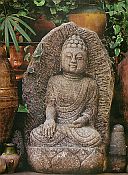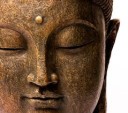|
· Tools of the trade
o A comfortable chair that supports your back or preferably,
o A comfortable cushion under your buttocks that lifts your seat and helps stabilize your posture in an upright position.
o A simple kitchen timer.
o A clean, quiet and pleasant place in your home.
o Altar accouterments can include a candle, an image, a small Buddha statue - anything that might help you feel “in the presence of”.
· Posture suggestions
o It takes some time to strengthen the stomach and lower back muscles that aid in maintaining a comfortable seated posture.
o You can use a deep inhalation to naturally lengthen the spine, soften the belly and open the chest, but it is not necessary to strain to maintain any posture.
o Empty-hands (a conscious softening of the hands and fingers) helps to bring relaxation to the arms and shoulders, which may permeate other parts of the body.
o A soft belly and relaxed jaw are good places to remember (be aware of) in order to gauge any subtle tension that may be held habitually.
o We cannot force deep relaxation, but we can listen for it and be available to it, welcoming the natural waves of softening and vulnerability that precede interludes of absorption.
· The Process
o We are engaging in a challenging and formidable relationship with restlessness and diversion. We may be struggling with question(s) of why meditation is worth practicing despite the internal call we may have to explore these inner landscapes.
o We use the timer to keep track of the time so we are not looking at a watch to see how long it's been; set the timer for what practice period you are comfortable with to begin your journey. Settle into your self and let the timer remind you when your sitting period has ended.
o Practicing at the same time of day (rhythm) is helpful, so if you are wishing to practice in the morning, make it each morning. Shorter duration sits at least twice a day is beneficial.
o The length of your practice time will increase naturally as quietude replaces apprehension. You will find that your interest in being still and silent improves as your body and mind integrate deepening relaxation.
o When this happens (and it surely will), you may increase the duration on your timer by 5 – 10 minutes, or whatever modest increments satisfy you.
o The silly stories about “great” yogis meditating for hours at a time are useless for the beginner. These long periods of “Samadhi” (absorption) occur, but they are not the goal for our simple practice.
o Without much effort (if there is some routine and regular practice) you will find that the quality of your sitting practice naturally deepens and that the joy which emanates from your stillness holds your attention and interest.
o Of course there are many nuances, levels, and subtleties associated with the labyrinth of our minds and personal experience. Being able to comprehend and articulate these encounters is improved by practicing with others and sharing the journey with those who have first hand experience with contemplative and complementary practice experience.
· What to Do
o Your thinking, planning and judging mind is useless when it comes to understanding silence, so you may put it away. Contemplative understanding unfolds and speaks in silence.
o Understand that the content of thinking and the sense of a separate self (that emanates from thinking) is a total hallucination – which doesn’t require your attention. We are learning to feel ourselves immersed in presence, rather than be occupied by imagination and personal story telling.
o Leave the mind alone, it is not real.
o For the time that you have agreed to practice, be still, be silent, listen to the whole song of creation/existence rather than focus on your private and imaginary predicament(s).
o Do nothing, in a sense all that is necessary is to explore (with friendly curiosity) the temptations to be elsewhere and other than now. Though it sounds paradoxical, continue to do nothing.
o It can be useful (according to the formal teachings) to bring your attention to the rhythm of your breath and the physical movement of air into and out of the nostrils. This is a tool to assist you in improving the sustainability of your concentration and attention. Additionally, sooner than later, full spectrum (body, mind, spirit) presence will also arise within you making it unnecessary to focus on the breath exclusively.
o In time, the habit of escapism and obsessive justification will melt into a pleasant acquiescence affirming that Now is more nourishing than elsewhere. This is the entry point to arriving, to fulfillment.
· The Simple View
o The simple goal of meditation practice is to arrive.
o By arriving we mean that the habit of thinking and living in the perpetual day dream of elsewhere (not here, not now) ceases.
o When the energy (cellular caloric combustion) that is wasted on day dream becomes available for presence (or arriving), we find ourselves in a very different relationship with living.
o It is this hint of spaciousness and invitation to awaken that ultimately draws our attention inward to be still and silent and nourished by the unfathomable source of consciousness.
o What we find ourselves falling in love with, is ourselves, in the riveting presence of awake.
| 





